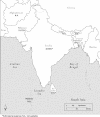Non-alcoholic Fatty Liver Disease in South Asians: A Review of the Literature
- PMID: 28507930
- PMCID: PMC5411360
- DOI: 10.14218/JCTH.2016.00045
Non-alcoholic Fatty Liver Disease in South Asians: A Review of the Literature
Abstract
Non-alcoholic fatty liver disease (NAFLD) and non-alcoholic steatohepatitis (NASH) are national and global epidemics. The disease is characterized by a spectrum of liver steatosis (fat deposition), inflammation (in NASH) and fibrosis. NAFLD and specifically NASH can lead to cirrhosis, which carry risks of progression to portal hypertension and hepatocellular carcinoma (HCC). NASH is also associated with higher mortality from cardiovascular causes. Most of the data for NAFLD has been obtained from the perspective of developed nations, although the disease is increasing and threatening to reach epidemic proportions across the world. Emerging data is notable for high prevalence of NAFLD in South Asian populations, presumably resulting from a combination of underlying genetic polymorphisms and changes in socio-economic status. It is also notable that an 'Asian Paradox' has been defined for NAFLD based upon the observation of lower than pre-defined body mass index (BMI), otherwise termed as "lean NAFLD", among this population. Yet, data remains limited in regards to the characteristics of NAFLD/NASH in this population. In this article, we present a review of the literature and discuss the prevalence, associated risk factors and burden of HCC in South Asians with NAFLD.
Keywords: Non-alcoholic fatty liver disease (NAFLD); Non-alcoholic steatohepatitis (NASH); South Asia.
Conflict of interest statement
The authors have no conflict of interests related to this publication.
Figures
Similar articles
-
Metabolic signatures across the full spectrum of non-alcoholic fatty liver disease.JHEP Rep. 2022 Mar 26;4(5):100477. doi: 10.1016/j.jhepr.2022.100477. eCollection 2022 May. JHEP Rep. 2022. PMID: 35434590 Free PMC article.
-
Clinical and Patient-Reported Outcomes From Patients With Nonalcoholic Fatty Liver Disease Across the World: Data From the Global Non-Alcoholic Steatohepatitis (NASH)/ Non-Alcoholic Fatty Liver Disease (NAFLD) Registry.Clin Gastroenterol Hepatol. 2022 Oct;20(10):2296-2306.e6. doi: 10.1016/j.cgh.2021.11.004. Epub 2021 Nov 9. Clin Gastroenterol Hepatol. 2022. PMID: 34768009
-
Epidemiology of non-alcoholic fatty liver disease and non-alcoholic steatohepatitis in Japan: A focused literature review.JGH Open. 2020 May 5;4(5):808-817. doi: 10.1002/jgh3.12349. eCollection 2020 Oct. JGH Open. 2020. PMID: 33102749 Free PMC article. Review.
-
Epidemiology and Natural History of Non-alcoholic Fatty Liver Disease.J Clin Exp Hepatol. 2012 Jun;2(2):135-44. doi: 10.1016/S0973-6883(12)60102-9. Epub 2012 Jul 21. J Clin Exp Hepatol. 2012. PMID: 25755422 Free PMC article.
-
Histopathology of nonalcoholic fatty liver disease/nonalcoholic steatohepatitis.World J Gastroenterol. 2014 Nov 14;20(42):15539-48. doi: 10.3748/wjg.v20.i42.15539. World J Gastroenterol. 2014. PMID: 25400438 Free PMC article. Review.
Cited by
-
Non-alcoholic fatty liver disease (NAFLD) in Filipino North American patients: Results from a multi-ethnic cohort.Can Liver J. 2022 Feb 4;5(1):4-13. doi: 10.3138/canlivj-2021-0025. eCollection 2022 Winter. Can Liver J. 2022. PMID: 35990788 Free PMC article.
-
Cohort profile: the Trivandrum non-alcoholic fatty liver disease (NAFLD) cohort.BMJ Open. 2019 May 5;9(5):e027244. doi: 10.1136/bmjopen-2018-027244. BMJ Open. 2019. PMID: 31061050 Free PMC article.
-
Adipose tissue-derived metabolite risk scores and risk for type 2 diabetes in South Asians.Int J Obes (Lond). 2024 May;48(5):668-673. doi: 10.1038/s41366-023-01457-4. Epub 2024 Jan 20. Int J Obes (Lond). 2024. PMID: 38245659 Free PMC article.
-
Prevalence of nonalcoholic fatty liver disease in Pakistan: a systematic review and meta-analysis.Sci Rep. 2024 Aug 23;14(1):19573. doi: 10.1038/s41598-024-70481-9. Sci Rep. 2024. PMID: 39179792 Free PMC article.
-
Work-up for Incidentally Detected NAFLD: How Far is It Worth?Euroasian J Hepatogastroenterol. 2022 Jul;12(Suppl 1):S26-S36. doi: 10.5005/jp-journals-10018-1364. Euroasian J Hepatogastroenterol. 2022. PMID: 36466102 Free PMC article. Review.
References
-
- Loomba R, Sanyal AJ. The global NAFLD epidemic. Nat Rev Gastroenterol Hepatol. 2013;10:686–690. doi: 10.1038/nrgastro.2013.171. - DOI - PubMed
-
- Rinella ME. Nonalcoholic fatty liver disease: a systematic review. JAMA. 2015;313:2263–2273. doi: 10.1001/jama.2015.5370. - DOI - PubMed
-
- Farrell GC, Wong VW, Chitturi S. NAFLD in Asia—as common and important as in the West. Nat Rev Gastroenterol Hepatol. 2013;10:307–318. doi: 10.1038/nrgastro.2013.34. - DOI - PubMed
-
- Sharma M, Mitnala S, Vishnubhotla RK, Mukherjee R, Reddy DN, Rao PN. The riddle of nonalcoholic fatty liver disease: progression from nonalcoholic fatty liver to nonalcoholic steatohepatitis. J Clin Exp Hepatol. 2015;5:147–158. doi: 10.1016/j.jceh.2015.02.002. - DOI - PMC - PubMed
-
- Browning JD, Szczepaniak LS, Dobbins R, Nuremberg P, Horton JD, Cohen JC, et al. Prevalence of hepatic steatosis in an urban population in the United States: impact of ethnicity. Hepatology. 2004;40:1387–1395. doi: 10.1002/hep.20466. - DOI - PubMed
Publication types
LinkOut - more resources
Full Text Sources
Other Literature Sources

